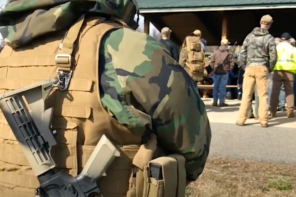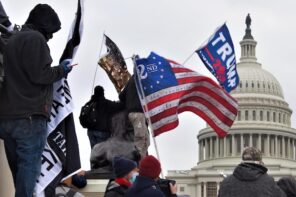While the horrific scenes of the invasion and occupation of the US Capitol building were played out on television, I happened to be in a radio interview for my new book, God at War. The reporter asked if there were similarities between the Trump-incited rioters and the terrorists I have studied. I quickly responded “yes.”
Here’s why. Though it’s true that the reasons for insurrections are different—supporters of the Islamic State are not the same as militant Buddhists in Myanmar, for example—all the violent extra-legal acts of force aimed against public order that I’ve studied have some common features, including symbolic empowerment, performance violence, and cosmic war.
Symbolic empowerment
When MAGA-hat wearing rioters carrying Confederate flags climbed through broken windows of the US Capitol, they were asserting that they, rather than elected officials, had the right to claim that space. Even more striking were pictures of a bare-chested protestor with a Viking hat—identified as Jake Angeli who calls himself “Q Shaman”—flexing beside the Speaker’s chair of the House of Representatives, and a grinning rioter—identified as Richard Barnett, since arrested—sitting in Speaker Nancy Pelosi’s office chair, his feet propped on her desk.
It’s virtually the same portrayal of power exhibited by Timothy McVeigh in destroying a federal building in Oklahoma City. A similar show of force was made by Abu Bakr al Baghdadi in installing himself on the balcony of the most important mosque of the city of Mosul and proclaiming himself Caliph of the Islamic State. (Similarly, acts of political assassination are frequent devices of terrorists since they not only remove a perceived enemy but also symbolically present themselves as more powerful than the leaders they kill.)
These are symbolic demonstrations of power; but they’re not real power. Within a couple of hours the Capitol rioters were driven out of the building. Before the end of the day of his attack, Timothy McVeigh was apprehended and brought to justice. Assassins are often killed on the spot. Al Baghdadi took longer to overcome, but eventually he and his ISIS were destroyed.
Yet in the moments they dominated the news and occupied public spaces, people without power asserted that they had it. In the case of ISIS, the movement appealed to the Sunni Arabs of Western Iraq and Eastern Syria who felt disenfranchised by the Shi’a dominated governments of Baghdad and Damascus. In the case of Trump’s stormtroopers who invaded the Capitol, many of them were white heterosexual Christians disturbed at the increasing multiculturalism of American society and the attempts to expand governmental power to provide welfare benefits to all. For a variety of reasons they felt alienated and humiliated in a new world order that seems to leave them behind. For a moment, however, sitting in the Speaker’s chair in the US Capitol, they imagined themselves to be in charge.
Performance violence
The fact that the whole world was watching this assault on the US citadel of democracy was part of the point. The young bare-chested man with the Viking hat must have known that his picture was being taken and soon would be displayed on television and in newspapers and repeated on social media on the internet.
The intention of terrorism is to terrorize. It is those who witness acts of violence and are terrified by them who give definition to the term. Certainly the members of Congress who lay shaking on the floor of the House chambers felt the terror of the moment, as did all of us watching the moments from a distance on television. Without an audience, such intimidating displays of violence wouldn’t have any effect.
If the orders to march on the Capitol were given by Donald Trump in the evening and the agitators tramped down the street to occupy the building in the dead of night, it wouldn’t have been much of an issue. It’s unlikely that television cameras would be there, and the lighting would have been insufficient. Trump and his followers chose the fullness of daytime, during a moment when all Senators and Representatives were meeting on the most fateful moment of the ascension of a new President, the ritual tallying of electoral votes that would proclaim Joseph Biden and Kamala Harris as leaders of the new administration.
If terrorism is theater, then timing and staging are significant. And in this case the timing of the electoral vote tally was perfect and the Capitol stage set could not have been better. As soon as the reserve forces of police and the National Guard came to the Capitol with smoke bombs and strength in numbers, the drama was over. The actors—many of whom seemed appropriately costumed for militant theater—meekly left the stage.
It’s a frequent characteristic of terrorist acts to choose a time and place of significance. Timothy McVeigh chose a date with various meanings, including the execution date of the leader of a Christian militant group with which McVeigh had some association; the 9/11 attack on the World Trade Center and Pentagon could not have had a more apt set of locations for an assault meant to show the vulnerability of America’s economic and military power. In a similar way the organizers of the Trump riot chose a date and place that maximized their attempts to portray a symbolic power to the whole nation, and beyond that, to the entire world. Fortunately, however, the symbols fade quickly and what remains is the image of a sad failed coup by what seemed to be a crazed mob.
Cosmic War
From the point of view of those engaged in the Capitol assault, however, there was nothing crazy about it. The one person who was killed by a Capitol policeman as she tried to climb on a ledge leading to the Speaker’s Lobby was a woman who had served with distinction in the US Air Force. According to the New York Times, she was wrapped in a Make America Great Again flag and shot as she tried to climb through a window that would have enabled her and other rioters to access the room where the members of the House of Representatives were sequestered.
The 35-year-old woman, Ashli Babbitt, had flown to Washington from her home in San Diego at the behest of Donald Trump who urged his supporters to interfere with the electoral vote tally. She had served for twelve years, including being a security guard for US Air Force bases, and had risen to the rank of Senior Airman. Her husband, who remained in San Diego, described her as an enthusiastic supporter of the President, but not emotionally unstable.
Like Timothy McVeigh, who had also served in the military—in his case, in Desert Storm—Babbitt may have considered herself to be engaged in another military struggle. They may have seen themselves as warriors in a great mission, certain to be dangerous, likely to be violent, but justified by the nobility of its cause.
It may seem strange that what appear to be ordinary and sensible people can be drawn into a situation where they commit the most hideous of violent acts. But this is precisely what the image of war enables. Warfare provides an alternative worldview to normal public order in which almost anything is permitted in order to conquer those perceived to be enemies. In warfare, enemies are things with which you cannot reason or negotiate; they can only be destroyed.
Most wars are conducted for political purposes that are authorized by a state regime accountable to laws and the moral constraints of the people who support it. The great theorist of war, Carl von Clausewitz, reasoned that these forms of war are diluted versions of the most basic kind of war—absolute war—in which there can be no hostages or peace treaties. These wars are sometimes conducted not for political purposes but because they’re perceived as protecting civilization itself, an existential war between good and evil, right and wrong. These are cosmic wars, in that they touch on a transcendent sense of moral and spiritual struggle. They’re often therefore imbued with religious significance.
Most of the terrorist acts that I’ve studied are products of these cosmic wars. When I interviewed one of the jihadi activists associated with al Qaeda who was involved in the 1993 attack on the World Trade Center he told me that he wasn’t a terrorist, but a soldier. Though I didn’t recognize the army of which he was a part or see the battle that he imagined, they were real in his mind. He leaned over and whispered, “you don’t see it, Mr. Mark, but there’s a war going on, a battle of good and evil, religion and irreligion—and your government is the enemy.”
In a similar way Ashli Babbitt and her fellow insurrectionists may have thought that there was a war going on, and that she was called to serve in it. Just as she did in the military, she took orders from her commander, and tried to faithfully execute them. At the Capitol on that fateful day she was able to be active in a real scene of battle in the way that her twelve years of military service as a security guard probably hadn’t allowed her to do. In the struggle for control of the capitol, Ashli Babbitt was a soldier again. Though she broke laws and windows and eventually lost her life in the process, for a time she was a warrior in a great cosmic war.





